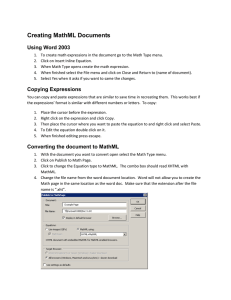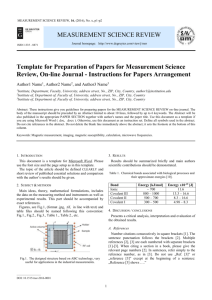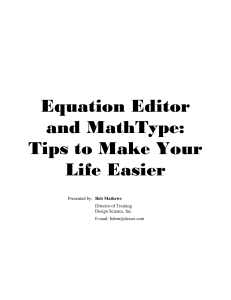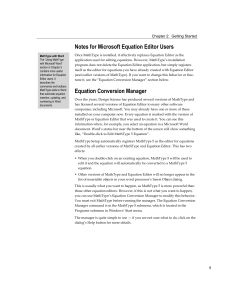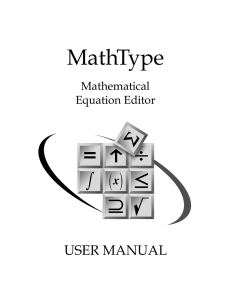Literature Survey
advertisement
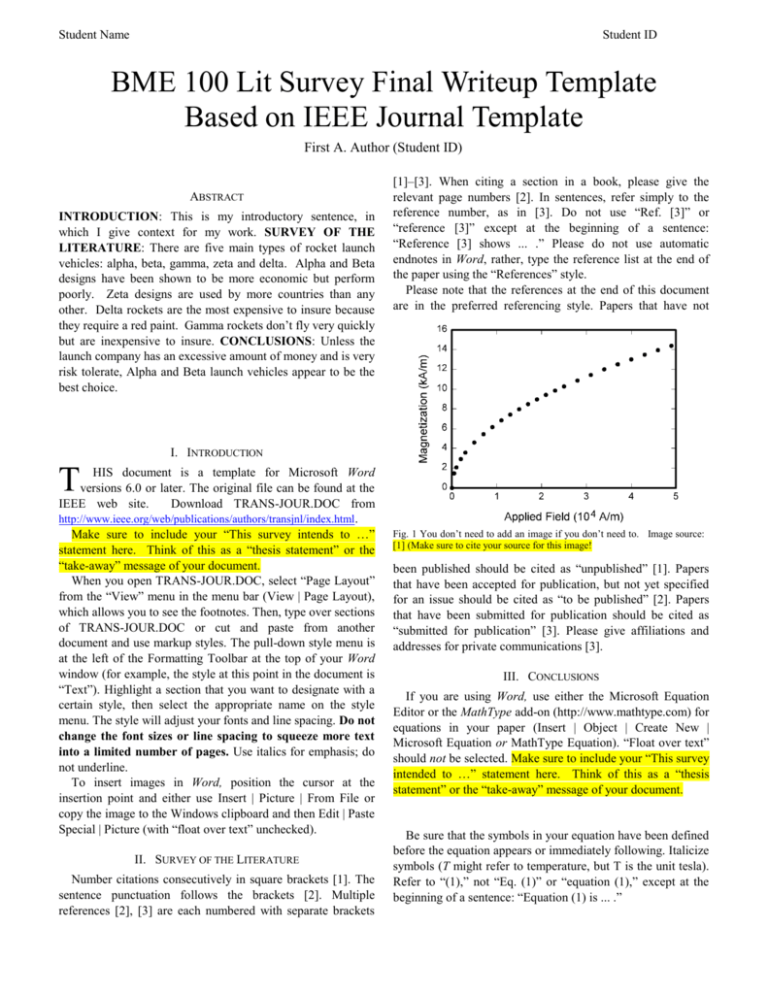
Student Name Student ID BME 100 Lit Survey Final Writeup Template Based on IEEE Journal Template First A. Author (Student ID) ABSTRACT INTRODUCTION: This is my introductory sentence, in which I give context for my work. SURVEY OF THE LITERATURE: There are five main types of rocket launch vehicles: alpha, beta, gamma, zeta and delta. Alpha and Beta designs have been shown to be more economic but perform poorly. Zeta designs are used by more countries than any other. Delta rockets are the most expensive to insure because they require a red paint. Gamma rockets don’t fly very quickly but are inexpensive to insure. CONCLUSIONS: Unless the launch company has an excessive amount of money and is very risk tolerate, Alpha and Beta launch vehicles appear to be the best choice. [1]–[3]. When citing a section in a book, please give the relevant page numbers [2]. In sentences, refer simply to the reference number, as in [3]. Do not use “Ref. [3]” or “reference [3]” except at the beginning of a sentence: “Reference [3] shows ... .” Please do not use automatic endnotes in Word, rather, type the reference list at the end of the paper using the “References” style. Please note that the references at the end of this document are in the preferred referencing style. Papers that have not I. INTRODUCTION T HIS document is a template for Microsoft Word versions 6.0 or later. The original file can be found at the IEEE web site. Download TRANS-JOUR.DOC from http://www.ieee.org/web/publications/authors/transjnl/index.html. Make sure to include your “This survey intends to …” statement here. Think of this as a “thesis statement” or the “take-away” message of your document. When you open TRANS-JOUR.DOC, select “Page Layout” from the “View” menu in the menu bar (View | Page Layout), which allows you to see the footnotes. Then, type over sections of TRANS-JOUR.DOC or cut and paste from another document and use markup styles. The pull-down style menu is at the left of the Formatting Toolbar at the top of your Word window (for example, the style at this point in the document is “Text”). Highlight a section that you want to designate with a certain style, then select the appropriate name on the style menu. The style will adjust your fonts and line spacing. Do not change the font sizes or line spacing to squeeze more text into a limited number of pages. Use italics for emphasis; do not underline. To insert images in Word, position the cursor at the insertion point and either use Insert | Picture | From File or copy the image to the Windows clipboard and then Edit | Paste Special | Picture (with “float over text” unchecked). II. SURVEY OF THE LITERATURE Number citations consecutively in square brackets [1]. The sentence punctuation follows the brackets [2]. Multiple references [2], [3] are each numbered with separate brackets Fig. 1 You don’t need to add an image if you don’t need to. Image source: [1] (Make sure to cite your source for this image! been published should be cited as “unpublished” [1]. Papers that have been accepted for publication, but not yet specified for an issue should be cited as “to be published” [2]. Papers that have been submitted for publication should be cited as “submitted for publication” [3]. Please give affiliations and addresses for private communications [3]. III. CONCLUSIONS If you are using Word, use either the Microsoft Equation Editor or the MathType add-on (http://www.mathtype.com) for equations in your paper (Insert | Object | Create New | Microsoft Equation or MathType Equation). “Float over text” should not be selected. Make sure to include your “This survey intended to …” statement here. Think of this as a “thesis statement” or the “take-away” message of your document. Be sure that the symbols in your equation have been defined before the equation appears or immediately following. Italicize symbols (T might refer to temperature, but T is the unit tesla). Refer to “(1),” not “Eq. (1)” or “equation (1),” except at the beginning of a sentence: “Equation (1) is ... .” Student Name Student ID REFERENCES [1] [2] [3] G. O. Young, “Synthetic structure of industrial plastics (Book style with paper title and editor),” in Plastics, 2nd ed. vol. 3, J. Peters, Ed. New York: McGraw-Hill, 1964, pp. 15–64. W.-K. Chen, Linear Networks and Systems (Book style). Belmont, CA: Wadsworth, 1993, pp. 123–135. H. Poor, An Introduction to Signal Detection and Estimation. New York: Springer-Verlag, 1985, ch. 4. . (Note that your Refworks output may look a little different… make sure that you have all the right information in your Refworks citations) TABLE I UNITS FOR MAGNETIC PROPERTIES. SOURCE: [2] (CITE YOUR SOURCE!) Symbol B Quantity Conversion from Gaussian and CGS EMU to SI a magnetic flux 1 Mx 108 Wb = 108 V·s magnetic flux density, 1 G 104 T = 104 Wb/m2 magnetic induction Vertical lines are optional in tables. Statements that serve as captions for the entire table do not need footnote letters.
